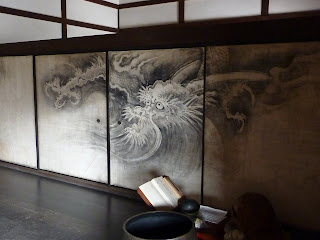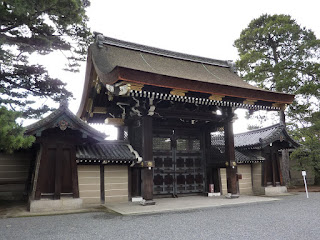* Not too hard to get around - unlike Tokyo the buses are all marked in English and there is a great bus map available with cute pictures of the main attractions.
On our first day we walked up the entire east side of the city (our guidebook suggested this was feasible in a day, which was a touch ambitious, and the descriptions and maps could have done with more detail to help us find everything), which was very enjoyable despite some rain. On the second day we picked up a bus pass and hit some highlights of the north-west, which are a little further apart.
We then took a tour of the Imperial Palace - supposed to have done this the previous day, oops, but fortunately in the off-season it was simple to turn up half an hour before the tour and book it. Unlike its counterpart in Tokyo, which is by turns powerful (the old bits) and functional (the new bits), the Kyoto palace is elegant and well worth seeing - plus the tour is in English rather than Japanese-with-an-audioguide.
And on the third day we visited the medieval castle, Nijo-jo, the manga museum, and a few other bits we'd missed. I still had a list of things to see - maybe another time...
This is a bit of a list of what we visited - but I've now added photos, which will hopefully make it much more interesting. It would take a long time to describe all of the wonderful sights of Kyoto - a really top destination, we were advised to spend at least 3 days here and that's a good call.
Sanjusangen-do - 1000 statues of thousand-armed Kannon (actually they each have 21 pairs of arms, each arm representing 25 worlds plus a pair to pray with). These are about 5 feet tall and all slightly different (most by different sculptors), so it's an impressive sight - 42,000 golden arms and not one of them has made it into a cricket career... (No photos allowed, unfortunately.)
We accidentally wandered through a huge graveyard. This photo is only about 10% of it...
Kiyomizu-dera perches above a valley, apparently a beautiful view in spring and autumn.
Sannen-zaka and Ninen-zaka, old lanes of traditional machiya houses, now reasonably classy (i.e. non-identikit) shops for tourists but still an atmospheric stroll.
Kodai-ji gardens and its small temple.
Small temple in Maruyama-koen park that felt like a tropical forest (I forget its name, we visited it by accident while looking for a bigger temple that we never found and were so hungry that we gave up searching).
Yasaka-jinja, a jolt of red at the end of the park.
After lunch, we went north through a huge red torii - Lilly shown for scale in the photo below -
- to Heian-jingu, an attractive temple.
Konchi-in had a nice garden.
Up the Philosopher's Path to Ginkaku-ji, which had the best garden of the lot, though the "Silver Pavilion" has no silver (nice little Phoenix on top though). We had rushed here to beat closing time but a stroll around the garden had us feeling better in no time. They do good gardens, the Japanese.
Day 2: Kinkaku-ji does have a gilded pavilion (and another little Phoenix), though it was destroyed in 1950 and rebuilt in 1957. The little garden around it was a good start to our day.
Daitoku-ji is a big complex of temples but we only went to Ryogen-in and Daisen-in, both with nice Zen gardens (the latter had an interesting written interpretation of the rocks and gravel, and we had green tea and a local biscuit whose name escapes me).
Gorgeous painted screen from interior
This is the type of detailing you get all over the place here
Then we did the Imperial Palace tour and wandered in gusty snow through its large but undistinguished park.
Day 3:
Nijo-jo was a good, solid castle but not outstandingly beautiful on the outside. Every inch of the inside is decorated with paintings or carvings, and there's a bit of important history there (the Shogunate was dissolved there, shortly before the Emperor moved the capital to Tokyo).
The International Manga Museum is mainly a library - the basement offers a short but interesting history of manga. The special exhibition was a travelling exhibit from the US about women in American comics, which wasn't particularly interesting and had nothing added to it to indicate the position of women in Japanese manga. Bit of a disappointment. Considering how mad they are for manga over here*, you'd hope for a bit more in terms of both historical context and original artwork. But if you want to read manga (or their small collection of foreign language reprints) it would be great.
* It's sold everywhere, everyone reads it (the middle-aged woman I was sat next to on our first Shinkansen was reading manga), several of our hotels have had little manga collections for guests to read, and we stuck our heads in a dedicated manga library in Hiroshima which was heaving with people on a Sunday afternoon).
Osamu Tezuka's Phoenix
Finally, two near our hotel which we'd been saving for if we had time: Kikoku-tei (aka Shosei-en) garden, which belongs to Higashi-Hongen-ji, a huge wooden temple, newly restored (with more work still ongoing). These were both great, especially as we had the former pretty much to ourselves - very peaceful.


















No comments:
Post a Comment